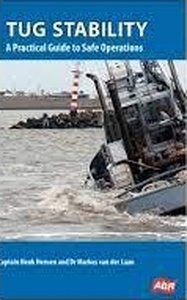Tug Stability A Practical Guide to Safe Operations

Formato papel
[Sin existencias. Plazo de entrega breve]
PVP. 45,00€
Tug Stability A Practical Guide to Safe Operations
FICHA TÉCNICA
- Editorial: The ABR Company Limited
- ISBN: 978-1-904050-29-2
- Idioma: Castellano
- Dimensiones:
0 cm x 0 cm
- Nº páginas: 0
- Materias: Estiba y transporte /
Numerous harbour tugs have capsized, often with tragic consequences: during the five-year period 2010-2015, more than 45 people are known to have drowned in capsizing incidents.
Stability is a complex subject and mainly a specialism of naval architects. Tug masters seldom have this detailed knowledge - yet they experience the effects of a tug's stability every day when manoeuvring their tug, either free sailing or when assisting ships.
Tugs will often be working with towline forces, hydrodynamic forces, steering and propulsion forces at or near their maximum with respect to the vessel's stability. It is, therefore, not just desirable but necessary for tug masters to have at least a basic idea of the elements of stability. They need to know where the limits are, and what the consequences could be, if tug handling practices don't conform to the rules of stability in normal circumstances and also when extreme conditions such as dense fog and storms occur.
Furthermore, a tug's stability is not a static condition but can change with every moment. Alterations in the amount of bunkers or stores, water on deck, slack tanks and ice accretion, all complicate the stability situation. These various factors could combine to affect stability in a negative way and may even culminate in a very dangerous situation for the tug.
In writing this handbook, master mariner and pilot Captain Henk Hensen and naval architect Dr Markus van der Laan have focussed on the practical aspects of stability, tug design and equipment and also on the consequences of unsafe procedures. Their emphasis is on harbour tugs, although several of the topics covered apply equally to seagoing tugs.
Formato papel
[Sin existencias. Plazo de entrega breve]
PVP. 45,00€
Libros Recomendados
-
[Sin existencias. Plazo de entrega breve]
PVP. 24,00€



